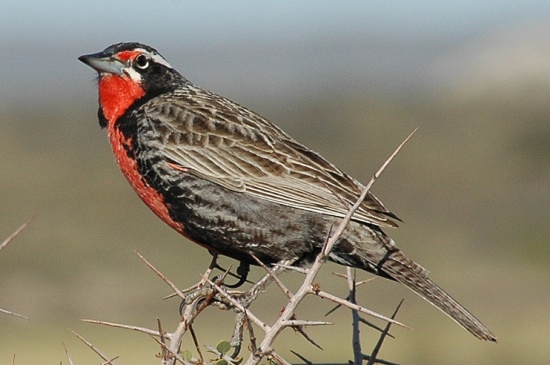- Leistes loyca
Sturnella loyca
Identification
Length 24.0-25.5 cm, wingspan 11.4-13.1 cm, weight 67-131 g. Female markedly smaller, with apparently no overlap in wing length and little in tail length.
Male: Overall heavily streaked grey-brown with strong white supercillium (red nearest bill), very dark side of head with thin white submoustacial stripe. Strong, straight, grey, pointed bill. Bright red breast. White underwing.
Female: Supercilium and throat buffy, underside mostly streaked similar to upperside, pale pink area to central belly and lower breast.
Distribution
Southern Chile, southern Argentina, and the Falkland Islands.
Taxonomy
In the past, this taxon has been included in Pampas Meadowlark.
Clements places this species in the genus Sturnella.
Subspecies
There are three subspecies recognized[1]:
- L. l. catamarcanus:
- North-western Argentina (Jujuy and Catamarca)
- L. l. loyca:
- L. l. falklandicus: this is the largest, with the longest bill
Subspecies obscura is not generally recognised.
Habitat
Coastal areas, meadow land and tussock grass, often with rocks.
Behaviour
Breeding
Nests are made by the female and are woven from grass, with an entrance tunnel, and are hidden amongst ground vegetation or gorse. Sub-species falklandica - female builds a nest of dry grass, hidden on ground or in tussock grass.
Late Aug--late Nov, 2-4 blue-white eggs, blotched purple and black are laid and incubated by the female for about 14 days. Both parents feed the young and probably raise two broods per season.
Diet
Diet includes worms, grubs, beetles, caterpillars and marine invertebrates taken from the shore.
References
- Clements, J. F., T. S. Schulenberg, M. J. Iliff, B.L. Sullivan, C. L. Wood, and D. Roberson. 2013. The eBird/Clements checklist of birds of the world: Version 6.8., with updates to August 2013. Downloaded from http://www.birds.cornell.edu/clementschecklist/download/
- Avibase
Recommended Citation
- BirdForum Opus contributors. (2024) Long-tailed Meadowlark. In: BirdForum, the forum for wild birds and birding. Retrieved 15 May 2024 from https://www.birdforum.net/opus/Long-tailed_Meadowlark
External Links





